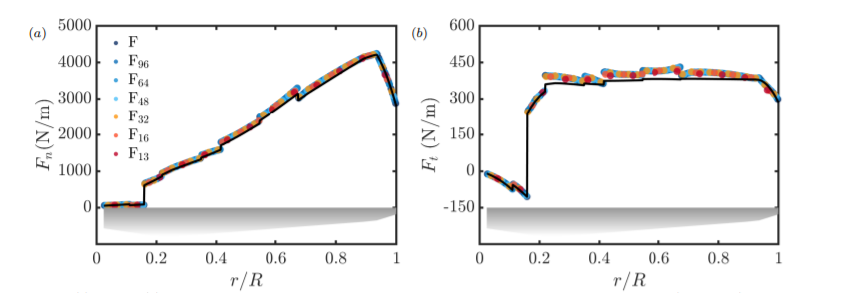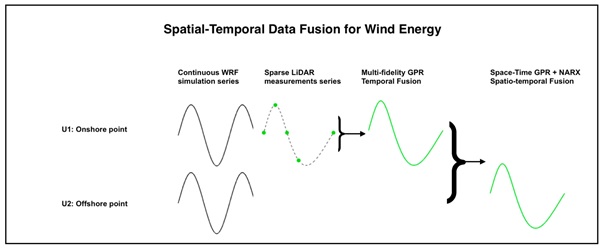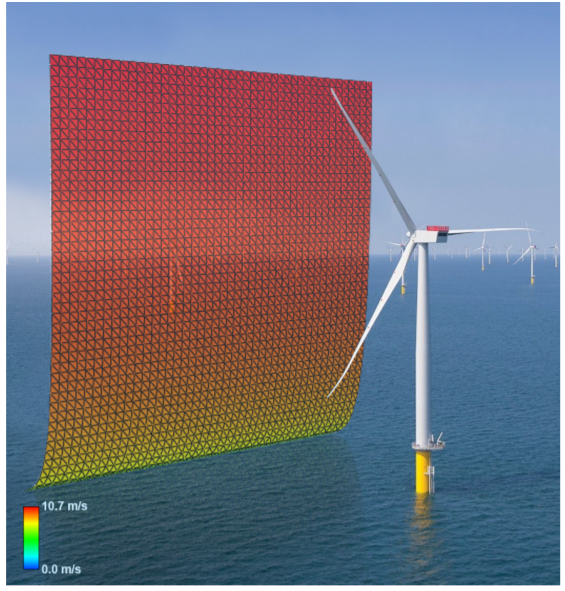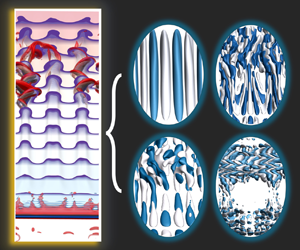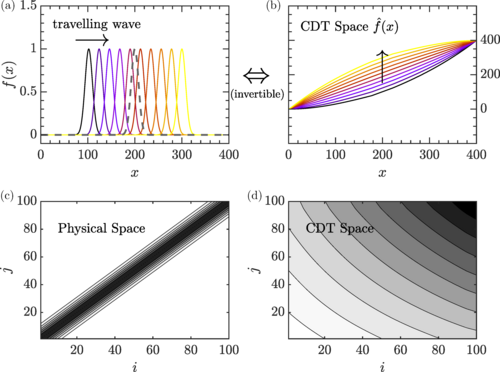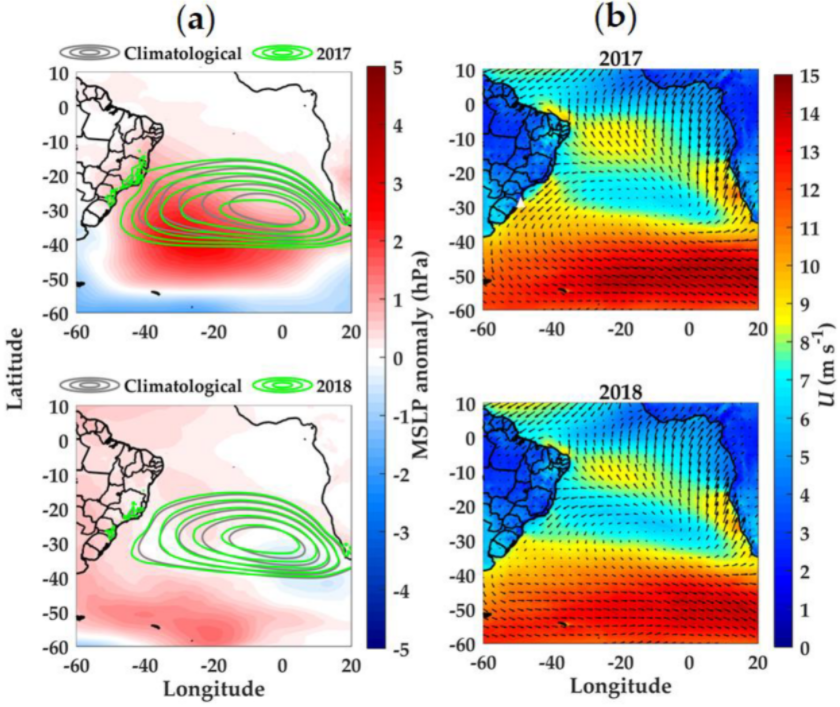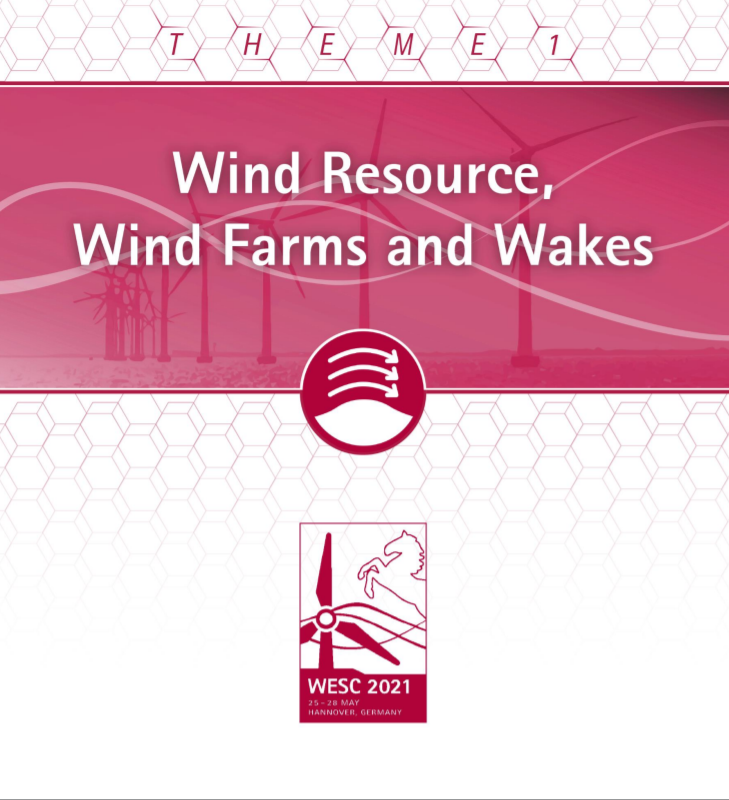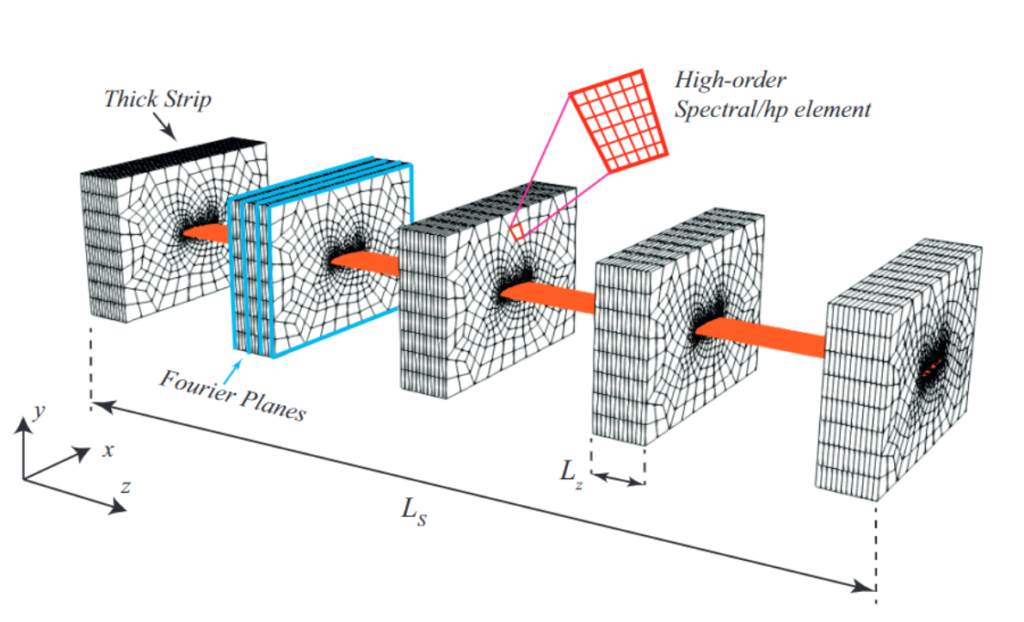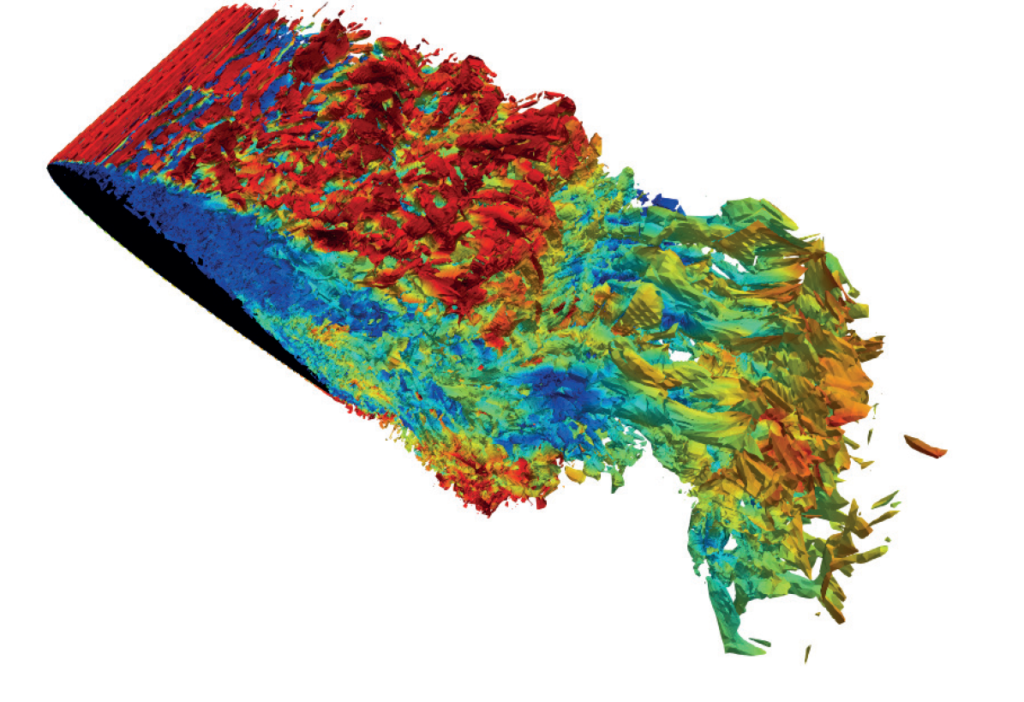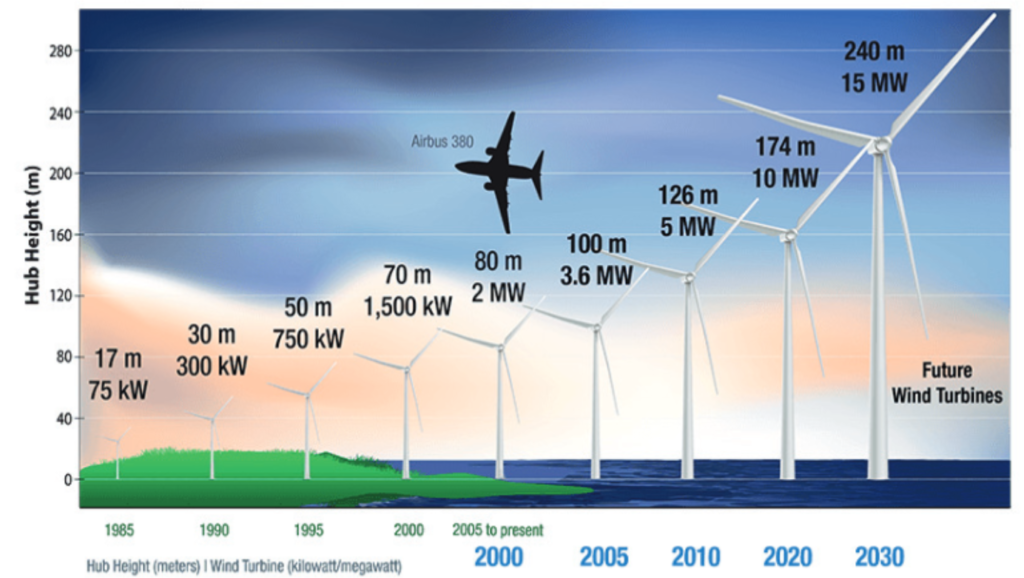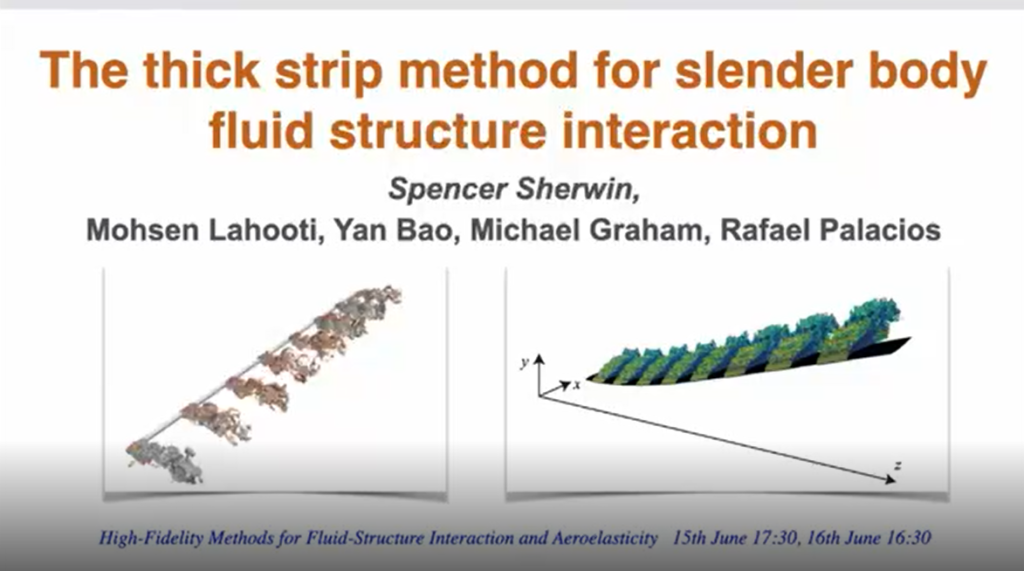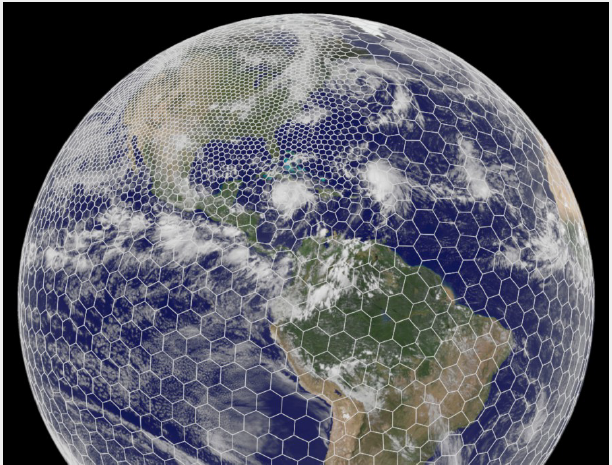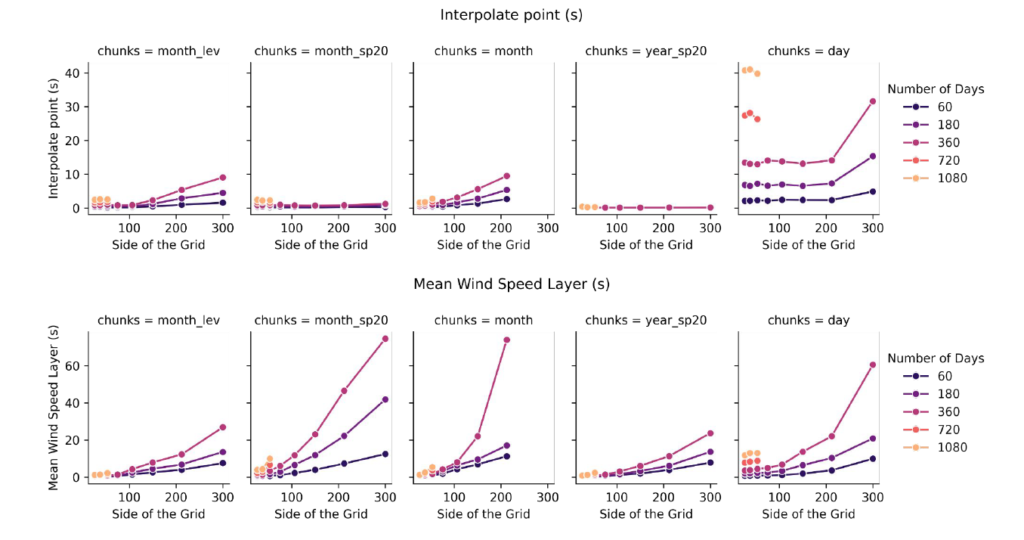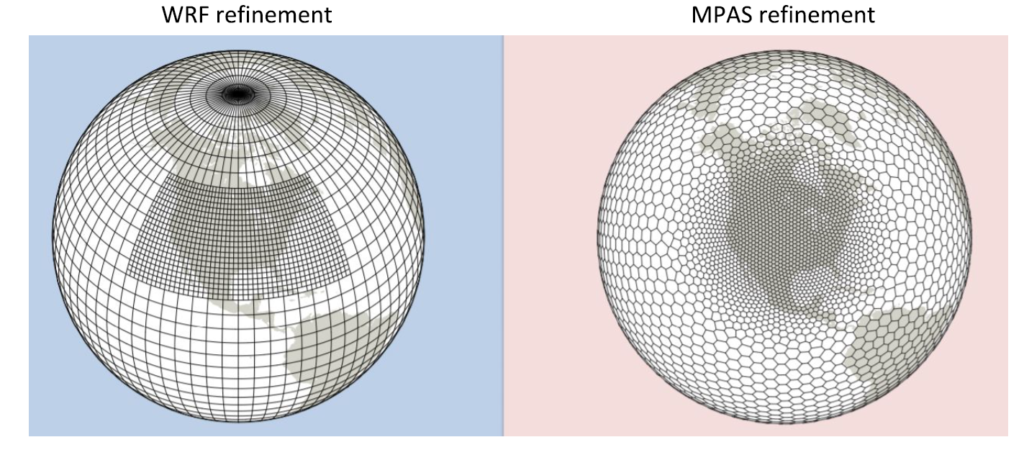Publications
White Papers
Researchers in the wind energy sector are increasingly using mesoscale modelling for wind resource assessment. The modelling has moved a long way since it was first used in the mid-1990s. These studies, which influence country and regional energy planning, help those in the wind energy sector:
• Map wind energy resources for energy planners.
• Determine renewable energy development zones.
• Develop pathways to acquire and adopt renewable energy technology.
Knowing that wind turbine and wind farm dynamics range in length scales, we used algorithms focused on these varying aspects to study the impact that flow dynamics have on wind turbines, blades and
wind farms. Our High-Performance Computing for Wind Energy (HPCWE) project addresses the development of algorithms for large-eddy simulations — a technique for simulating turbulent flows
with high fidelity — to show the fluid-structure interaction (FSI) and aeroelastic coupling of wind turbine blades. By studying FSI, we are able to observe the interaction between a flexible structure and the fluid flow stream.
Scientific Publications
Evaluating the accuracy of the actuator line model against blade element momentum theory in uniform inflow
Authors: Luoqin Liu, Lucas Franceschini, Daniel F. Oliveira, Flavio C. C. Galeazzo, Bruno S. Carmo, Richard J. A. M. Stevens (2022). Read paper
Abstract: We evaluate the accuracy of the actuator line model (ALM) approach by performing simulations for the NREL 5 MW wind turbine in uniform inflow using three large eddy simulation codes. The power and thrust coefficients obtained using the three codes agrees within 1% when the grid spacing ∆grid ≤ 5.25 m, and are cross-validated against blade element momentum (BEM) theory. We find that the results of ALM converge towards BEM theory without the need for tip correction when the numerical resolution is increased. For ∆grid = 0.98 m the difference between the power and thrust coefficient obtained using ALM and BEM is 4.5% and 2.1%, respectively, although we note that no absolute convergence between ALM and BEM can be obtained as both models use different assumptions, such as the use of a force projection method in the ALM. The difference in the local axial and tangential forces along the blades obtained from ALM simulations using ∆grid = 1.97 m and ∆grid = 0.98 m can be as large as 10%. The effect of the number of actuator points on the obtained turbine power and thrust coefficients is limited as the results converge when the spacing between the actuator points is about three times the grid spacing. This insight on the required number of blade points can be used to improve the efficiency of actuator line simulations.
LES/DNS fluid-structure interaction simulation of non-linear slender structures in Nektar++ framework
Authors: Mohsen Lahooti, Yan Bao, Ankang Gao, David Scott, Rafael Palacios, Spencer Sherwin.
[in review for Computer Physics Communication]
Optimising adjoint models through persistent memory storage
Authors: Adrian Jackson, Xuerui Mao (2021).
[Manuscript submitted for publication]
A hybrid solution for offshore wind resource assessment from limited onshore measurements
Authors: Basem Elshafei, Alfredo Peña, Dong Xu, Jie Ren, Jake Badger, Felipe M Pimenta, Donald Giddings, Xuerui Mao (2021). Read paper
Abstract: In wind resource assessments, which are critical to the pre-construction of wind farms, measurements by LiDARs or masts are a source of high-fidelity data, but are expensive and scarce in space and time, particularly for offshore sites. On the other hand, numerical simulations, using for example the Weather Research and Forecasting (WRF) model, generate temporally and spatially continuous data with relatively low-fidelity. A hybrid approach is proposed here to combine the merit of measurements and simulations for the assessment of offshore wind. Firstly a temporal data fusion using deep Multi Fidelity Gaussian Process Regression (MF-GPR) is performed to combine the intermittent measurement and the continuous simulation data at an onshore location. Then a spatial data fusion using a neural network with Non-linear Autoregression (NAR) and Non-linear Autoregression with external input (NARX) are conducted to project the wind from onshore to offshore. The numerical and measured wind speeds along the west coast of Denmark were used to evaluate the method. We show that the proposed data fusion technique using a gappy onshore measurement results in accurate offshore wind resource assessment within a 2% margin error.
Blade-Resolved Numerical Simulations of the NREL Offshore 5 MW Baseline Wind Turbine in Full Scale: A Study of Proper Solver Configuration and Discretization Strategies
Authors: de Oliveira, Marielle and Puraca, Rodolfo Curci and Carmo, Bruno Souza (2021). Available at SSRN: Read paper
Abstract: This paper presents a blade-resolved numerical investigation of the NREL 5 MW baseline wind turbine for offshore
applications including blade-tower interference, analyzing the solver configuration and its influence on the results
accuracy and computational costs. The wind turbine was analyzed considering its full dimensions under the operating
condition of optimal wind-power conversion efficiency for a wind speed of 10 m/s at hub height. The power production, generated thrust, and forces distribution along the blade span were estimated. The computational analyses were
carried out using a Computational Fluid Dynamics (CFD) methodology employing the Finite Volume Method (FVM)
implemented in the OpenFOAM software considering different approaches of the Pressure Implicit Split Operator
(PISO) solver and different mesh refinement strategies for the spatial discretization process, which resulted in two
different meshes being investigated. For one of the meshes, a temporal discretization analysis was performed for three
different CFL numbers. The iterative form of the PISO algorithm was considered in its generic form and with an extra
step to correct the pressure before the beginning of the iterative process in each time step. Both approaches can be
accomplished in OpenFOAM through the PIMPLE solver facilities for the treatment of the pressure-velocity coupling
in unsteady problems. The analysis of the transient incompressible turbulent flow was conducted considering the same
turbulence model for all CFD investigations, the URANS k − ω SST. A numerical verification was conducted in each
analysis by comparing the CFD results against values obtained using the blade element momentum theory, implemented in OpenFAST. To conclude each analysis, a computational cost investigation was carried out. Finally, for the
spatial and temporal discretization investigation, detailed information regarding the flow characteristics is presented.
According to the accuracy of the results obtained through the CFD simulations, the best numerical arrangement is
given by the iterative PISO with face flux correction as pressure-based solver and a temporal discretization which
employs lower values of CFL, such as 1 or 2.
Image-based flow decomposition using empirical wavelet transform
Authors: Ren, J., Mao, X., & Fu, S. (2021). Image-based flow decomposition using empirical wavelet transform. Journal of Fluid Mechanics, 906, A22. Read paper
Abstract: We propose an image-based flow decomposition developed from the two-dimensional (2-D) tensor empirical wavelet transform (EWT) (Gilles, IEEE Trans. Signal Process., vol. 61, 2013, pp. 3999–4010). The idea is to decompose the instantaneous flow data, or their visualisation, adaptively according to the averaged Fourier supports for the identification of spatially localised structures. The resulting EWT modes stand for the decomposed flows, and each accounts for part of the spectrum, illustrating fluid physics with different scales superimposed in the original flow. With the proposed method, decomposition of an instantaneous three-dimensional (3-D) flow becomes feasible without resorting to its time series. Examples first focus on the interaction between a jet plume and 2-D wake, where only experimental visualisations are available. The proposed method is capable of separating the jet/wake flows and their instabilities. Then the decomposition is applied to an early-stage boundary layer transition, where direct numerical simulations provided a full dataset. The tested inputs are the 3-D flow data and their visualisation using streamwise velocity and λ2 vortex identification criterion. With both types of inputs, EWT modes robustly extract the streamwise-elongated streaks, multiple secondary instabilities and helical vortex filaments. Results from 2-D stability analysis justify the EWT modes that represent the streak instabilities. In contrast to proper orthogonal decomposition or dynamic modal decomposition that extract spatial modes according to energy or frequency, EWT provides a new strategy for decomposing an instantaneous flow from its spatial scales.
Model reduction of traveling-wave problems via Radon cumulative distribution transform
Authors: Ren, J., Wolf, W. R., & Mao, X. (2021). Physical Review Fluids, 6(8), L082501. Read paper
Abstract: Traveling-wave problems, due to their sizable Kolmogorov n-width, have brought critical challenges to conventional model reduction techniques. This study aims to provide insights into this problem by exploiting the Radon cumulative distribution transform (R-CDT) [Kolouri, Park, and Rohde, IEEE Trans. Image Process. 25, 920 (2016)], which has emerged in the sector of computer vision science. The core lies in the unique property of the nonlinear invertible R-CDT that renders both traveling and scaling components into amplitude modulations. In contrast to the physical space, a substantial model reduction is achieved in the R-CDT space while sustaining high accuracy. The method is parameter-free and data-driven and lends itself to problems regardless of the dimensions or boundary conditions. Examples start with a one-dimensional Burgers’ equation subject to nonperiodic boundary conditions, where both traveling and diffusion dominate the physics. In higher-dimensional problems, we show the model reduction of traveling Gaussian solitons. In addition to foreseeable motions, the proposed method is capable of handling random traveling with a nondifferentiable trajectory.
Thick Strip Method for Efficient Large-Eddy Simulations of Flexible Wings in Stall
Authors: Mohsen Lahooti, Rafael Palacios, Spencer J. Sherwin, Imperial College London AIAA SciTech conference. Read paper
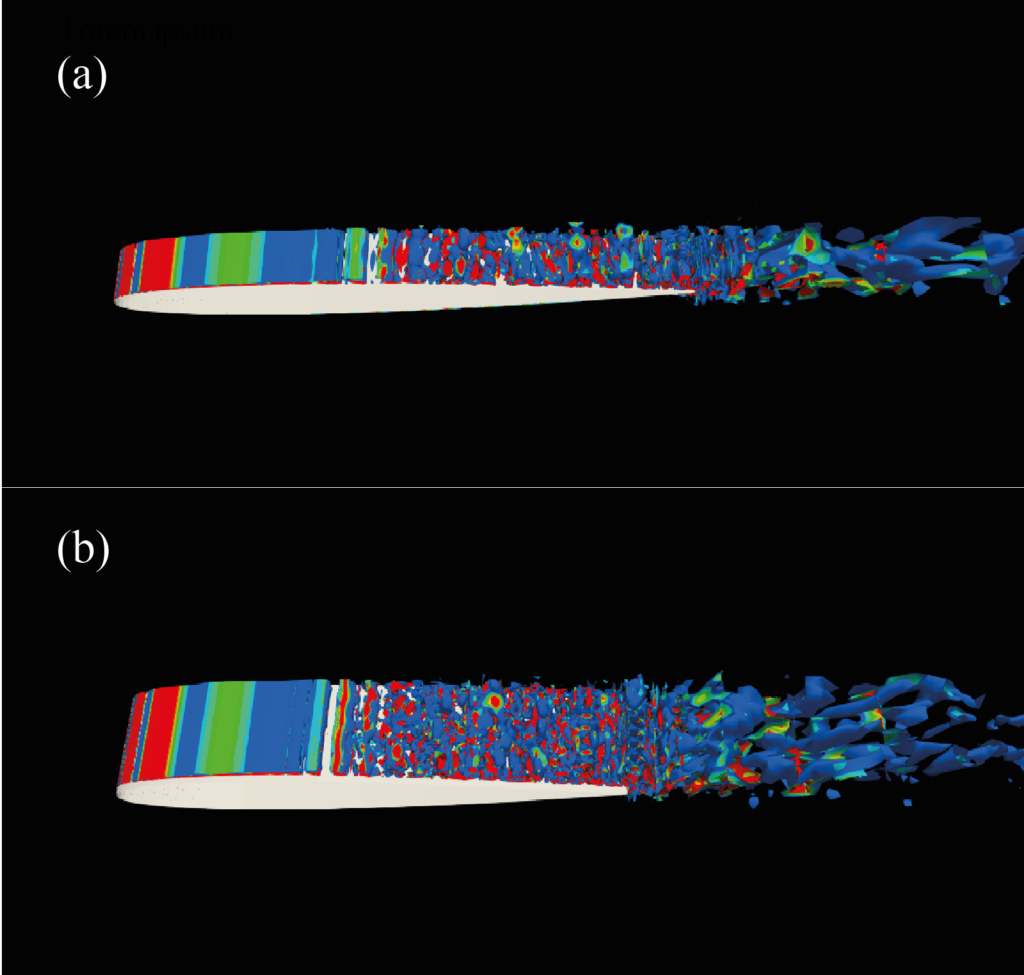
Coastal Wind Power in Southern Santa Catarina, Brazil
Authors: César Henrique Mattos Pires, Felipe M. Pimenta, Carla A. D’Aquino, Osvaldo R. Saavedra, Xuerui Mao and Arcilan T. Assireu (2020). Read paper
Abstract: A light detection and ranging (LIDAR) wind profiler was used to estimate the wind speed in the southern coast of Santa Catarina State, Brazil. This profiler was installed on a coastal platform 250 m from the beach, and recorded wind speed and direction from January 2017 to December 2018. The power generation from three wind turbines was simulated, to obtain estimations of the average power, energy generation and capacity factor, as well as to assess the performance of a hypothetical wind farm. The scale and shape parameters of the Weibull distribution were evaluated and compared with those of other localities in the state. The prevailing winds tend to blow predominantly from the northeast and southwest directions. Wind magnitudes are higher for the NE and SW ocean sectors where the average wind power density can reach 610–820 W m−2. The Vestas 3.0 turbine spent the largest percentage of time in operation (>76%). The higher incidence of strong northeasterly winds in 2017 and more frequent passage of cold fronts in 2018 were attributed to the cycle of the South Atlantic subtropical high. The results demonstrate a significant coastal wind power potential, and suggest that there is a significant increase of resources offshore.
Enhancing Temporal Extrapolation of Wind Speed Using a Hybrid Technique: A Case Study in West Coast of Denmark
Authors: B Elshafei, X Mao (2020). Read paper
Abstract: The demand for renewable energy is significantly increasing, major investments are being supplied to the wind power generation industry as a leading source of clean energy. The wind energy sector is entirely dependable and driven by the prediction of wind speed, which by the nature of wind is very stochastic and widely random. This study employs deep multi-fidelity Gaussian process regression, used to predict wind speeds for medium term time horizons. Data of the RUNE experiment in the west coast of Denmark were provided by the Technical University of Denmark, which represent the wind speed across the study area from the period between December 2015 and March 2016. The study aims to investigate the effect of pre-processing the data by denoising the signal using empirical wavelet transform (EWT) and engaging the vector components of wind speed to increase the number of input data layers for data fusion using deep multi-fidelity Gaussian process regression (GPR). The outcomes were compared using root mean square error (RMSE) and the results demonstrated a significant increase in the accuracy of predictions which demonstrated that using vector components of the wind speed as additional predictors exhibits more accurate predictions than strategies that ignore them, reflecting the importance of the inclusion of all sub data and pre-processing signals for wind speed forecasting models.
Conference Proceedings, Presentations & Recordings
A model-chain for wind resource assessment in complex terrain via statistical-dynamical downscaling using dynamical tendencies for meso-micro coupling
Authors: Bjarke Tobias Olsen, and Dalibor Cavar (2021).
Read the conference proceedings (pp. 224-225)
On the scalability of a single wind turbine simulation using the code WInc3D
Authors: Flavio Cesar Cunha Galeazzo, Lucas Franceschini, Bruno Carmo, and Andreas Ruopp (2021).
Read the conference proceedings (pp. 80-81)
Actuator line modeling: efficiency improvements and code comparisons
Authors: Luoquin Liu, Lucas Franceschini, Daniel Francisconi Oliveira, Flavio Cesar Cunha Galeazzo, Bruno Souza Carmo, and Richard Stevens (2021).
Read the conference proceedings (pp. 74-75)
Wall Resolved Fluid-structure Interaction Numerical Simulations of a modern wind turbine blade
Authors: Lahooti, Mohsen; Puraca, Rodulfo; Carmo, Bruno; Palacios, Rafael; Sherwin, Spencer (2021). See presentation slides and Watch the presentation
Wall-resolved fluid-structure interaction (FSI) numerical simulations of the NREL 5 MW wind turbine blade are compared using two FSI approaches. The first method is based on high-fidelity Nektar++/SHARPy FSI framework, where the fluid governing equations are solved using high-order spectral/hp element method and the turbulent flow is resolved using Large Eddy Simulation (LES) on thick strips, while large-deformation dynamics of the structure are modelled using a geometrically exact nonlinear composite beam finite-element model. Thick strip method for the fluid reduces the computational cost by considering a series of smaller domains, each of which has a finite thickness in the spanwise direction. Hence, the overall flow over the blade is treated with a sectional approach, where in each of these sections, strips, the 3D flow is reconstructed locally. Tip-loss correction is used to compensate for the sectional approach over the blade. The second FSI approach is based on OpenFoam/Calculix coupling, where the second-order unstructured finite volume method approach is used for solving the three-dimensional flow equations and the flow turbulence is captured using the k-ω SST model. The structural dynamics are modeled via second-order finite element method using standard solid elements. Effects of the solution fidelity on the prediction of aerodynamic forces as well as on the full three-dimensional flow modelling over the blade versus sectional representation of flow over the blade while incorporating the local three-dimensionality in each section and tip-correction are discussed. Further, significance of two approaches on modelling
the slender blade, one using the beam mode and the other utilizing the full 3D solution of structure is addressed. Finally,
assessment of computational cost and scalability of the two approaches are presented and discussed.
Wall-Resolved FSI Simulation of Modern Turbine Blades: Assessment of fidelity on the aerodynamic forces and deformation of the blade
Authors: Lahooti, Mohsen; Puraca, Rodolfo; Carmo, Bruno; Palacios, Rafael; Sherwin, Spencer (2021). See presentation slides
Modern wind turbine blades feature long blades to increase the harvesting capacity of the turbine. However, with increasing the size of the blades, comes the flexibility which introduces new design aspects for modern wind turbines and requires aeroelastic and vortex-induced vibration (VIV) simulations to be considered in the design process. High-fidelity fluid-structure interaction (FSI) simulation of such blades is computationally challenging due to the combined effect of large deformations on the blade and the presence of locally or globally separated flows at high Reynolds numbers. Hence, distinct levels of fidelity are required when targeting various aspects of design such as the effect of flexibility in power generation or VIV of blades in parked conditions. This work presents an assessment of the effect of fidelity on the captured flow features and predicted deformation of a highly deformable slender structure representing the typical turbine blades. Comparisons are made between the results of two FSI solvers, Nektar++/SHARPy FSI framework [1] and OpenFoam/Calculix FSI solver.
High-fidelity aeroelastic simulation of flexible wings inseparated flows
Authors: Lahooti, Mohsen; Palacios, Rafael; Sherwin, Spencer (2021). See presentation slides
An efficient high-fidelity FSI method is developed for aeroelastic simulations of highly deformable streamlined structures in separated flows with a non-constant cross-section over the structure span. The method is the further development of our Nektar++/SHARPy FSI solver [1] to support non-constant sectional geometry over the structural span as well as introducing correction factor for tip loss effect. The FSI solver has implemented in Nektar++ [2] framework where the Navier-Stokes equation is discretized and solved using the high-order spectral/hp element method. Large-Eddy Simulation (LES) method is used to resolve the turbulent structures in highly separated flow condition and accurately predict the fluid forces on the structure. To reduce the computational cost of LES simulation over the slender structure, the thick-strip method [3] is adopted where the full 3D fluid domain is represented with series of separated smaller domains, each of which has a finite thickness in the spanwise direction. Having the finite thickness for the strips enables capturing local 3D wake turbulent while representing the full 3D domain with a finite number of smaller domains reduces the overall computational cost of LES simulation over the slender structure. The thick strips are separated domains that implicitly connected via the structural dynamics. Hence, a correction factor based on the calculated circulation in each strip is introduced to take into account the tip-loss effect. To support independent geometry and meshes for each strip, the hybrid parallelism approach [4] of Nektar++ is further modified which enable having non-constant cross-sections over the span. Large-deformation dynamics of the structure is modelled using a geometrically-exact
composite beam finite-element model [5]. Simulation results of deformation of NREL5 MW reference wind turbine blade [6] in high angle of attack with large separating flow over the blade is presented and the computational challenges and requirements for such simulations are discussed in the present research.
The thick strip method for slender body fluid structure interaction
Authors: S. Sherwin, M. Lahooti, Y. Bao, M. Graham, R. Palacios (2021). Watch the presentation
Revisiting Mesoscale: how MPAS can make wind resource modeling really seamless
Author: Marta Gil Baradji, Vortex FDC (2021). See presentation slides
Abstract: At Wind Europe (8-10 September 2021), Marta Gil Bardají from Vortex held a presentation on “Revisiting Mesoscale: how MPAS can make wind resource modeling really seamless”. More information about Wind Europe: https://windeurope.org/tech2021/programme/
The use of zarr files to store and study 4D wind flow BLOCKS.
Authors: Marta Gil-Bardaji (2021). See poster
Abstract: Current atmospheric modeling is technically capable of generating historical wind data time series over a region for several heights. This 4-dimensional gridded time series data set is what we internally name BLOCKS at Vortex and will allow wind engineers to study the wind flow in great detail and use it as input for complex calibration, wakes and
production studies. Besides the computational challenges of performing such a simulation for high resolutions
and long periods of time, another limitation is the storage and handling of the data set itself. BLOCKS are so voluminous and complex that traditional wind software formats are inadequate to deal with them (yet) and this hinders their widespread. Fortunately, there exist interesting candidates to become the next industry standard and in this presentation
we will show why Vortex has chosen one of them: the Zarr files. Zarr is a cloud-friendly data format implemented in Python that stores chunked, compressed N-dimensional arrays [1]. Zarr is a young project but already very popular especially in parallel computing and cloud storage contexts. A key feature of a zarr file is that the data arrays are divided into chunks (pieces) and each chunk is compressed. The optimal chunk shape depends on how one will access the data and the performance can vary greatly if chunks are chosen differently. Therefore, choosing the correct chunking for the data is the essential decision to create the “best” zarr possible.
How MPAS can make wind resource modeling really seamless
Author: Marta Gil Baradji, Vortex FDC (2021). See poster
Abstract: A different perspective to improve the modeling chain has been opened by a new modeling framework which is intended to replace the Weather Research and Forecasting (WRF) system in the mid-term. This perspective brings a new approach to revisit the global and mesoscale modeling inter connection and to build a fully seamless atmospheric downscaling modeling solution named Model for Prediction Across Scales (MPAS). The present study shows the first analysis of MPAS suitability for wind resource assessment applications and, in the context of an early development stage, offers encouraging results from MPAS when compared to WRF.

